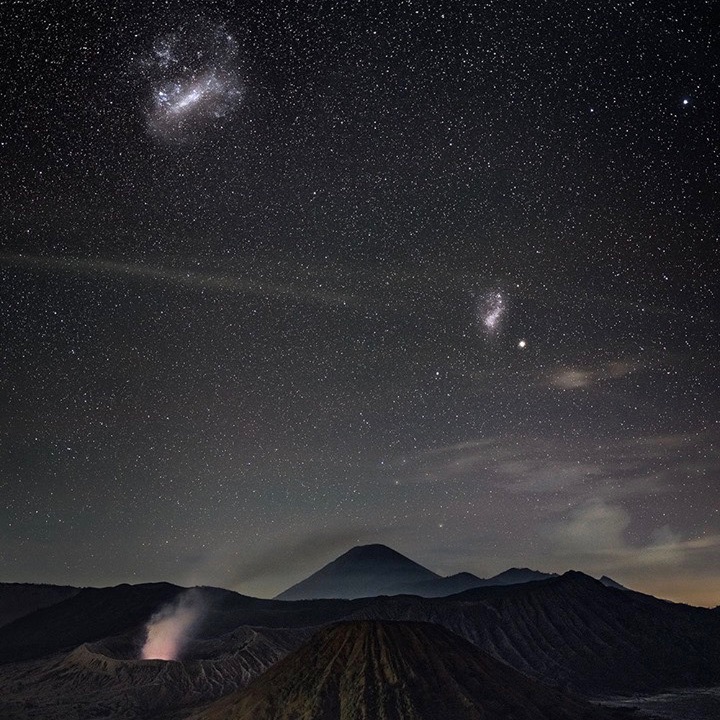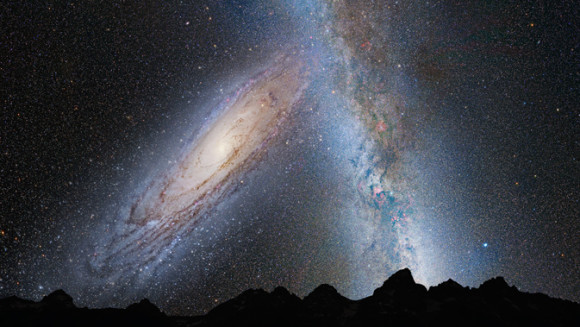
Best New Year’s gift ever! EarthSky moon calendar for 2019
A catastrophic galaxy collision could send our solar system flying into space. That’s the conclusion of new research conducted via the EAGLE Project – a comprehensive computer simulation aimed at understanding how galaxies form and evolve – conducted on some of the world’s largest supercomputers. Astrophysicists at Durham University’s Institute for Computational Cosmology, working with the University of Helsinki in Finland, use data from the Eagle Project to predict a collision between our Milky Way galaxy and the nearby Large Magellanic Cloud. The collision might dislodge our solar system, and send it flying, some two billion years from now.
The new work was published January 4, 2019, in the peer-reviewed journal Monthly Notices of the Royal Astronomical Society.
Astronomers had earlier predicted an impact between our Milky Way and a much-larger neighboring galaxy, the Andromeda galaxy. Scientists say our two large galaxies will collide in some 8 billion years.
Before that happens, a collision between our Milky Way and the Large Magellanic Cloud might occur. If it happens, the collision could wake up our galaxy’s central, supermassive black hole, which would begin devouring surrounding gas and increase in size by up to 10 times. As it feeds, this future active black hole at the center of our Milky Way would throw out high-energy radiation. According to these scientists’ statement:
… while these cosmic fireworks are unlikely to affect life on Earth, the scientists say there is a small chance that the initial collision could send our solar system hurtling into space.

Galaxies like our own Milky Way are surrounded by a group of smaller satellite galaxies that orbit around them, in a similar way to how bees move around a hive. Typically, these satellite galaxies have a quiet life and orbit around their hosts for many billions of years. However, from time to time, they sink to the center, collide and are devoured by their host galaxy.
The Large Magellanic Cloud is the brightest satellite galaxy of the Milky Way and only entered our neighborhood about 1.5 billion years ago. It sits about 163,000 light-years from the Milky Way. Until recently astronomers thought that it would either orbit the Milky Way for many billions of years, or, since it moves so fast, escape from our galaxy’s gravitational pull.
However, recent measurements indicate that the Large Magellanic Cloud has nearly twice as much dark matter than previously thought. The researchers say that since it has a larger than expected mass, the Large Magellanic Cloud is rapidly losing energy and is doomed to collide with our galaxy.
The research team used the EAGLE galaxy formation supercomputer simulation to predict the collision. Marius Cautun, a postdoctoral fellow in Durham University’s Institute for Computational Cosmology, is lead author of the study. Cautun said:
While two billion years is an extremely long time compared to a human lifetime, it is a very short time on cosmic timescales.
The destruction of the Large Magellanic Cloud, as it is devoured by the Milky Way, will wreak havoc with our galaxy, waking up the black hole that lives at its center and turning our galaxy into an active galactic nucleus or quasar.
This phenomenon will generate powerful jets of high energy radiation emanating from just outside the black hole. While this will not affect our solar system, there is a small chance that we might not escape unscathed from the collision between the two galaxies which could knock us out of the Milky Way and into interstellar space.
The collision between the Large Magellanic Cloud and the Milky Way could be spectacular, the researchers say. Co-author Carlos Frenk, Director of the Institute for Computational Cosmology, Durham University, said:
Barring any disasters, like a major disturbance to the solar system, our descendants, if any, are in for a treat: a spectacular display of cosmic fireworks as the newly awakened supermassive black hole at the center of our galaxy reacts by emitting jets of extremely bright energetic radiation.

Bottom line: A new computer simulation suggests that the Large Magellanic Cloud is hurtling towards the Milky Way on a collision course that could knock our solar system out of the Milky Way.
Source: The aftermath of the Great Collision between our Galaxy and the Large Magellanic Cloud











